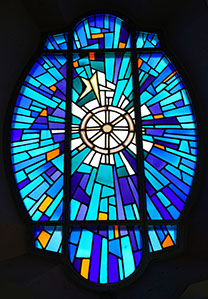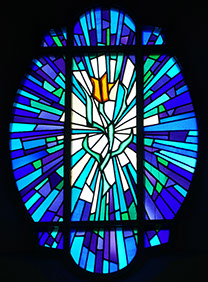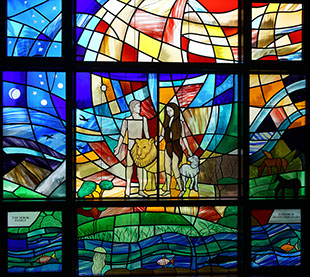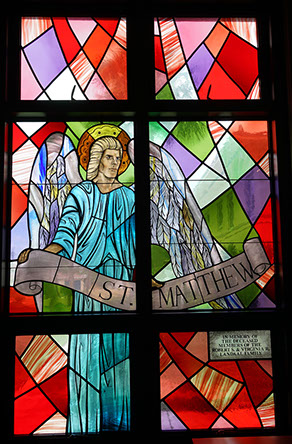STAINED GLASS
SEVEN CORPORAL WORKS of MERCY
THE SEVEN CORPORAL WORKS OF MERCY
We are blessed with beautiful stained-glass windows, but as you look at the ones in the high ceiling, or clerestory, you may wonder what these somewhat abstract symbols in the center of each window represent.
Let’s start on the north side or to the right as you look at the altar.
These are the Seven Corporal Works of Mercy plus an 8th window near the choir loft.
The Corporal Works of Mercy depict the physical needs of mankind. These are charitable actions that help our neighbors with basic needs as we journey together through this life.

The first nearest the altar is Feed the Hungry.
A yellow loaf of bread and a purple clump of grapes with a green leaf spill out of a yellow and orange cornucopia. We see this in action as we help at food pantries, shelters, and soup kitchens and donate financially or with food from our own abundance.
The next is Give Drink to the Thirsty.
Here, a blue handled cup is receiving water from a pitcher directly above it. This is evidenced in conserving water and creating clean water sources for those without access to this vital resource.
The third window is Clothe the Naked.
Here we have a red cloak with a very slender sword piercing it beginning at the upper left corner. It is angled upwards and ready to slice downwards. It reminds us of St. Martin splitting his cloak in half to give to the beggar. Any efforts to help those less fortunate with clothing, food and other necessities give evidence of this in action.
The fourth window is Visit the Imprisoned.
Represented by a red rose and a ball and chain. The gray ball is above the rose and gray shackles with chains hang below it. Prison ministries give inmates the opportunity to hear the Word of God and see kindness and mercy in their fellowman. We can all help with prayers for those who are incarcerated.
Next, we see Shelter the Homeless depicted by a yellow and green-gabled house in the center and a pale, yellow cross in front. The message that a Christian home should be a shelter for those in need can be realized by active work at shelters, refugee assistance, donations and, as always, prayers for those who are affected by a variety of circumstances depriving them of shelter.
The sixth window represents Visit the Sick with a rough-hewn brown wooded crutch and white bandages wrapping around it. All who are sick, and especially those with chronic illness, benefit from our prayers, visits, prepared meals and even help offered to their caregivers as a respite. Whether visiting nursing homes, hospitals or neighbors, your comforting presence is appreciated as you serve the community.
The last one is Bury the Dead depicted by woven green palm leaves wrapped around white linens. Funerals allow us to grieve, show respect for life and give comfort to others. Attending a funeral, sending a card or note to those in mourning, visiting cemeteries, praying for the departed and even preparing for our own corporal death shows we have hope in the Resurrection.
The last window on this side represents the Crown of Thorns and Nails of the Crucifixion. The green crown is in the center and two gray nails pierce it, reminding us of Jesus Christ’s ultimate sacrifice and that only through death do we rise again.
As your eye travels around the windows, you will see the familiar image of our patron saint, St. John Vianney, depicted in the window in the choir loft over the east entrance to the church. He is the patron saint of priests and was known for his commitment to confessions, which he heard continuously for up to 12 hours a day. He died August 4, 1859 and that is his feast day as well.








SPIRITUAL WORKS of MERCY
Now we will look at the stained-glass windows on the south side clerestory windows or left as you look at the altar. Once our corporal or bodily needs are met, the Spiritual Works of Mercy provide the emotional needs and spiritual nourishment that draws us closer to God.

We begin at the back of the church by the choir loft with Counsel the Doubtful. This is depicted by a brown and white ship’s steering wheel in the center and a yellow star
above it, guiding the ship. Despite occasional doubts, Christ is the Way, the Truth, and the Life, and the witness of our lives reveal this to others. Faith Formation classes, spiritual counsel and resources, and Sunday worship reinforce our faith, enabling us to share it with other.
The next window represents Instructing the Ignorant. An orange Lamp of Knowledge sits on top of a stack of yellow and orange books depicting this second Spiritual Work of Mercy.
Through instruction and self-directed study, we learn the theology and traditions of our faith, and then we are called to spread the Word through our actions. Mission trips, helping
with Religious Education or RCIA and sharing our faith with others are just some of the manifestations.
The third is Admonish the Sinner represented by a flowering hyssop plant with an orange bloom, which is referenced in Psalms 1:17. "Purge me with hyssop and I shall be clean." We are all sinners and all benefit from the support and guidance of one another to avoid sin and temptation. Heeding Matthew 7:5 "Remove the wooden beam from your eye first; then you will see clearly to remove the splinter from your brother’s eye," reminds us to avoid judging others as well.
Next, we have Comfort the Sorrowful depicted by a light purple incense burner with a cap in the center and a light blue veil drapes over it coming from the left, reminding us how
Veronica offered comfort to Jesus on the walk to Calvary. Anyone dealing with grief appreciates a listening ear, a card or even a shared meal. Small acts of kindness and letting them know they are being remembered can make a huge impact at a difficult time.
The fifth is Forgive all Injuries and shows brown shafts of wheat turned downwards. Wheat represents abundance, love and charity and upside down is pouring out this abundance to those who torment you, as Jesus showed us so many times. Forgiveness transforms our hearts and lives and participation in the Sacrament of Penance gifts us this in abundance.
Next is Bear Wrongs Patiently depicted by a brown yoke of an ox in the center with a U-shaped bow that goes under the ox’s neck running through it. Avoid bitterness from wrongs done against you, place your hope in God for a compassionate spirit and patience to bear our crosses on earth, as Jesus
did for all of us.
The last Spiritual Work of Mercy is Pray for the Living and the Dead. It is symbolized by the yellow Tau Cross of Life. The last letter in the Hebrew alphabet, Tau is rich in history
symbolizing life, immortality, resurrection and well-being. Collectively praying for the living and the dead entrusts us all into God’s care.
The last window on this side is nearest the altar and is a Chalice with Eucharist. A golden chalice with red trim and a host over the chalice represents the spiritual food we receive at each Eucharistic celebration, nourishing us to perform all the Corporal and Spiritual Works of Mercy. As St. John Vianney said: "There is nothing so great as the Eucharist. If God
had something more precious, He would have given it to us".







THE STORY of CREATION
Having completed the upper stained-glass windows, we will now look at the ground floor images. These are not original to the church and were installed in the early 2000’s. The openings were there, but they were large jalousie windows covered on the exterior with patterned concrete blocks. Rusted rebar and water damage required extensive renovations and the windows were then replaced with smoky gray glass. The renovation was done in the late 1990’s, at which time the bell tower was rebuilt as well. Once the dust settled, all ground floor windows became stained glass windows in stages, designed by Casola Stained Glass Studio in Ft. Meyers, FL.
We will start on the north side closest to the Altar with the story of Creation. These windows of the six days of Creation were the first created, commissioned in 2002. The first three days of Creation are represented here and encourage us to reflect on the scripture passages of Genesis.



The first Creation window represents Ge 1:1-5, depicting “Let there be light,” and the separation of night and day-the first day. It shows the breath of God which is mentioned many times in scripture as giving life, such as in Job 33:4 “The Spirit of God has made me: the breath of the Almighty gives me life.”
The next window shows the separation of earth and sea, by creating a dome in the middle of the waters, separating bodies of water. The dome was called “the sky.” God creates the world and gives names to His creations. This is Ge 1:6-8.
The third window is Ge 1:9-13, the third day. God directed that water be held in a basin, “the sea,” so that dry land, “the earth,” would appear. He directed the earth to bring forth vegetation and bear seeds and fruit, which we see in the trees and shrubs. The world begins to take shape.
We continue our Creation story on the south side, ground floor of the church with the last 3 days of Creation. Starting at the back of the church we have day 4, described in Ge 1:14-19. It depicts lights in the dome of the sky and two great lights to separate night and day and create fixed times. This window is filled with images: stars, planets, sun, moon, a falling star, sea, land, palm trees-familiar to the people of the locale. We now see seasons influenced by the marking of time with the sun and moon; spring and summer flowers, fall leaves, bare trees, snowflakes.
The next window is Gen 1:20-23, day 5. God created an abundance of living creatures in the water and birds of the air. The familiar “Be fruitful and multiply” is included in this passage. The window shows doves and other birds of the air, while the water teems with sea life; fish, whale, shark, dolphin, starfish, sea grass.
The 6th and final day of Creation brings all of God’s creations together in Ge 1:24-31. Now the earth will bring forth all kinds of living creatures and man is created in God’s image to have dominion over all, “Be fruitful and multiply” is repeated. Images include sun, moon, stars, planets, snowflakes, fish, jellyfish, birds, donkey, seagrass, leafy trees, bare trees, and Adam and Eve who are flanked by a lamb, representing Jesus Christ and a lion, a sign of resurrection. If we continued in Genesis, 2:7 tells us “God breathed life into his nostrils and the man became a living being”—again the breath of God which is where we started with the first Creation window.



BACK of the CHURCH

At the back of the church, we have two more windows on each side. On the north side, in the “Ushers Room” the window has four images from Exodus.
The top, center panel depicts Moses and the burning bush with his response to God “Here I am,” Ex 3:1–6. In the middle section, on the left, is Moses getting water from rock after the Israelites have complained of their hardships, Ex 17:3–6. It is followed by the large center panel showing the parting of the Red Sea rescuing the Israelites from the Egyptians, Ex 14:21–25, and lastly, on the far right middle section Moses receives the Ten Commandments from God, Ex 20:1–17.
On the south side, in the “Family Room” is the story of Noah and the flood from Ge 7:1–10. The rich and colorful imagery shows pairs of animals exiting the ark after the flood waters have receded and the rainbow has come out. Both windows show God’s deep love for us as he saves us, provides for us and leads us to a better place.

EVANGELISTS

The last of the stained-glass windows are those in the north and south transepts—completing the cross formation of the church structure itself. The four evangelists Matthew, Mark, Luke and John are represented here. They are all winged images referencing the vision of the Prophet Ezekiel where four winged creatures represent the four evangelists, Ezekiel 1:5–13. Let’s start on the south side with Matthew and Mark.
Beginning with Matthew, we see him depicted as a winged man or angel representing Christ’s incarnation, recalling his nature as both divine and human. Matthew is called the divine man because he teaches us about the humanity of Christ and gives us the genealogy of our Savior.
Mark emphasizes the majesty and royal dignity of Christ. He is depicted as a winged lion; the king of beasts. He begins his narrative with the prophetic voice of St. John the Baptist “the voice of one crying in the wilderness,” like the roar of a lion.
On the north side of the transept we will be looking at evangelists Luke and John, remembering that they are winged images referencing the vision of the Prophet Ezekiel where four winged creatures represent the four evangelists, Ezekiel 1:5–13.
Because St. Luke’s gospel focuses on the sacrificial atonement of Christ’s death, he is depicted as a winged ox. The ox has always been a traditional sacrificial animal in Judaism and pagan antiquity.
For John we have the majestic eagle whose keen gaze sees far beyond what is immediately present. John’s gospel opens with: "In the beginning was the Word, and the Word was with God, and the Word was God," the divine logos. The eagle is a symbol of that which comes from above. John is called The Eagle of Patmos, an island where he spent his last years in exile. The eagle symbol is prevalent in the church, as you see on our own ambo where the Gospel is proclaimed.



9/11 DEDICATION to the FIREFIGHTERS

As part of the window representing St. John, we also have an image of the World Trade Towers and a dedication to the firefighters of 9/11. Donated by the Dilley family, the windows are a tribute to the FDNY Engine Co. 8, Ladder Co. 2, Battalion 8 firefighters who lost their lives in that tragedy. Pictured here with Martha Dilley are lithographs of the windows inside the station house memorial to 9/11, on 51st Street in NYC. The lithographs are on the bottom corners. While living in NYC, Martha and her daughter Maggie came to know the fireman of 8 and 2 and visited often on return trips, becoming cherished visitors. Martha chose to dedicate windows to the 10 men lost from 8 and 2, and the thousands of others who perished that day. She wanted them placed with St. John’s eagle image that symbolizes scaling the heights of perfection and drawing closer to God, as well as honoring her deceased father and son, both named John.
Weekend Mass Times: Saturday 4:00 pm, Sunday 9:30 am & 11:30 am
Masses will take place in the church building or in the tent depending on construction circumstances.
FAITH EDUCATION
BROWSE

FIND US
If you need a priest please call 727.360.1147
445 82nd Avenue,
St. Pete Beach, Florida 33706
727.360.1147
REGISTRATION FOR THE PARISH
© 2024 SAINT JOHN VIANNEY PARISH | All Rights Reserved | Xclaim Agency